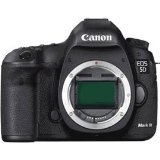We love being able to offer photographers the awesome camera giveaways that we do and we are thrilled that the upcoming winner will be able to choose from 3 different popular cameras as a prize. One lucky winner will get to choose from a Canon 5DS R, a Sony a7R or a Nikon D810.
Last week, we talked about the Sony a7R and all the great features it offers. If you have not seen it, be sure to read that post here. Today, we are going to do the same for the Canon 5DS R. Read on to see what this Canon model features and if this would be the perfect camera for you and your photography!
50.6 Megapixel Full-Fram CMOS Sensor
This camera features Canon's newest full-frame CMOS sensor. With 50.6 Megapixels, it is the highest resolution sensor in the history of EOS. It captures 8712 x 5813 effective pixels with a level of realism perfect for large-scale commercial printing, fine art, significant crops and any other high end applications.
Low-Pass Filter Effect Cancellation
If you are looking for the best in high resolution, this Canon has a Low-pass filter effect cancellation which is useful to reduce color artifacts and also reduces detail at the pixel level. If you have the Low-pass filter disabled, the 5DS R takes full advantage of the original resolving power of the cameras 50.6 Megapixel sensor.
EOS Scene Detection System with RGB+IR Metering Sensor
With an amazing iSA Intelligent Subject Analysis system, it employs an independent RGB light sensor with approximately 150,000 pixel resolution. This sensor enables the Intelligent Tracking and Recognition system that detects and tracks subjects, automatically switching the AF point to optimize tracking. There is also new tracking algorithms tailored to recognize faces and colors.
61-Point High Density Reticular AF
This camera has fast, precise AF with sophisticated tracking performance. It is incredibly sensitive to changes in composition, making adjustments quickly to help ensure consistent, sharp AF.
Shutter Release Time Lag
This new setting, offers an added protection against camera-shake blur by setting the shutter release time intentionally longer so the camera does not begin the next exposure until after the impact of the camera's mirror has diffused.
Advanced Mirror Control Mechanism
When you take photos, the shake that can occur from the impact of the SLR mirror can give you blurry details in your photos. This camera's mirror is not controlled by springs, but instead is driven by a small motor and cams which reduces impact and its effects on the image.
Anti-Flicker Feature For Better Accuracy
With this anti-flicker function, you can deliver accurate results under cycling lighting situations. For example, if you are in fluorescent lighting, a fast shutter speed may result in an irregular exposure. This function detects the frequency and phase of the flicker and captures images near the point of peak brightness when the subject is most likely well illuminated.
Full HD 30p Movie Capability
The Canon 5DS R is a movie-making machine! It captures full HD movies with numerous manual controls at multiple frame rates and compressions. The shutter button can also be programmed to capture still images when pressed during movie shooting.
Does this Canon camera sound amazing to you? Be sure to enter our current giveaway so you have a chance to win this camera for yourself! Be sure to read all about the Sony a7R and check back next week for information on the Nikon D810.





































